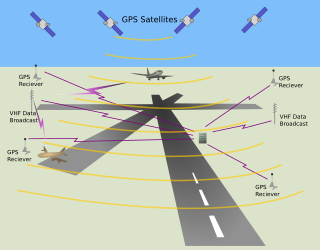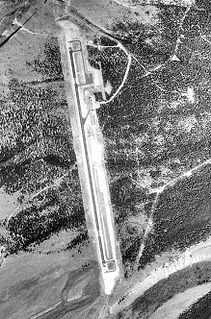
In aviation, instrument flight rules (IFR) is one of two sets of regulations governing all aspects of civil aviation aircraft operations; the other is visual flight rules (VFR).

According to the International Civil Aviation Organization (ICAO), a runway is a "defined rectangular area on a land aerodrome prepared for the landing and takeoff of aircraft". Runways may be a man-made surface or a natural surface. Runways, as well as taxiways and ramps, are sometimes referred to as "tarmac", though very few runways are built using tarmac. Takeoff and landing areas defined on the surface of water for seaplanes are generally referred to as waterways. Runway lengths are now commonly given in meters worldwide, except in North America where feet are commonly used.

In aviation, the instrument landing system (ILS) is a precision radio navigation system that provides short-range guidance to aircraft to allow them to approach a runway at night or in bad weather. In its original form, it allows an aircraft to approach until it is 200 feet (61 m) over the ground, within a 1⁄2 mile (800 m) of the runway. At that point the runway should be visible to the pilot; if it is not, they perform a missed approach. Bringing the aircraft this close to the runway dramatically increases the range of weather conditions in which a safe landing can be made. Other versions of the system, or "categories", have further reduced the minimum altitudes, runway visual ranges (RVRs), and transmitter and monitoring configurations designed depending on the normal expected weather patterns and airport safety requirements.

A heliport is a small airport suitable for use by helicopters and some other vertical lift aircraft. Designated heliports typically contain one or more touchdown and liftoff areas and may also have limited facilities such as fuel or hangars. In some larger towns and cities, customs facilities may also be available.

An airfield traffic pattern is a standard path followed by aircraft when taking off or landing while maintaining visual contact with the airfield.
Aviation is the design, development, production, operation, and use of aircraft, especially heavier-than-air aircraft. Articles related to aviation include:
A sky marshal is a covert law enforcement or counter-terrorist agent on board a commercial aircraft to counter aircraft hijackings. Such an agent is also known as an air marshal, a flight marshal, or an in-flight security officer (IFSO). Sky marshals may be provided by airlines such as El Al, or by government agencies such as the Austrian Einsatzkommando Cobra, Royal Canadian Mounted Police, German Federal Police, National Security Guard in India, Metropolitan Police SO19, Pakistan Airports Security Force or US Federal Air Marshal Service.

In the case of a radio failure or aircraft not equipped with a radio, or in the case of a deaf pilot, air traffic control may use a signal lamp to direct the aircraft. ICAO regulations require air traffic control towers to possess such signal lamps. The signal lamp has a focused bright beam and is capable of emitting three different colours: red, white and green. These colors may be flashed or steady, and have different meanings to aircraft in flight or on the ground. Planes can acknowledge the instruction by rocking their wings, moving the ailerons if on the ground, or by flashing their landing or navigation lights during hours of darkness. Air traffic control signal light guns are typically specified with a (white) center beam brightness of > 180,000 - 200,000 candela, and are visible for roughly 4 miles in clear daylight conditions. The table below describes the meaning of the signals. The use of handheld combination red/green/white signal lamps for air traffic control dates back to at least the 1930s.

A fixed-base operator (FBO) is an organization granted the right by an airport to operate at the airport and provide aeronautical services such as fueling, hangaring, tie-down and parking, aircraft rental, aircraft maintenance, flight instruction, and similar services. In common practice, an FBO is the primary provider of support services to general aviation operators at a public-use airport and is on land leased from the airport, or, in rare cases, adjacent property as a "through the fence operation". In many smaller airports serving general aviation in remote or modest communities, the town itself may provide fuel services and operate a basic FBO facility. Most FBOs doing business at airports of high to moderate traffic volume are non-governmental organizations, either privately or publicly held companies.

Livermore Municipal Airport is three miles west of Livermore, California, in Alameda County, California. The Federal Aviation Administration (FAA) National Plan of Integrated Airport Systems for 2017–2021 categorized it as a regional reliever facility.

Central Illinois Regional Airport at Bloomington-Normal is a public airport in McLean County, Illinois, three miles east of Bloomington and southeast of Normal. Owned by the Bloomington-Normal Airport Authority, it is also known as Central Illinois Regional Airport (CIRA).

The local-area augmentation system (LAAS) is an all-weather aircraft landing system based on real-time differential correction of the GPS signal. Local reference receivers located around the airport send data to a central location at the airport. This data is used to formulate a correction message, which is then transmitted to users via a VHF Data Link. A receiver on an aircraft uses this information to correct GPS signals, which then provides a standard ILS-style display to use while flying a precision approach. The FAA has stopped using the term LAAS and has transitioned to the International Civil Aviation Organization (ICAO) terminology of Ground-Based Augmentation System (GBAS). While the FAA has indefinitely delayed plans for federal GBAS acquisition, the system can be purchased by airports and installed as a Non-Federal navigation aid.
Taos Regional Airport is a public use airport eight nautical miles (15 km) northwest of the central business district of Taos, in Taos County, New Mexico, United States. It is owned by the Town of Taos. FAA's National Plan of Integrated Airport Systems for 2009–2013 classifies it as a general aviation airport.
West Bend Municipal Airport is a city-owned public-use airport located three nautical miles (6 km) east of the central business district of West Bend, a city in Washington County, Wisconsin, United States. It is included in the Federal Aviation Administration (FAA) National Plan of Integrated Airport Systems for 2021–2025, in which it is categorized as a regional reliever airport facility.

Lake County Airport, also known as Leadville Airport, is a county-owned public-use airport located two nautical miles (3.7 km) southwest of the central business district of Leadville, a city in Lake County, Colorado, United States.

Landing lights are lights, mounted on aircraft, that illuminate the terrain and runway ahead during takeoff and landing, as well as being used as a collision avoidance measure against other aircraft and bird strikes.
The Next Generation Air Transportation System (NextGen) is an ongoing modernization project of the United States National Airspace System (NAS). The U.S. Federal Aviation Administration (FAA) began work on NextGen improvements in 2007 and plans to finish the final implementation segment by 2030. The goals of the modernization include using new technologies and procedures to increase the safety, efficiency, capacity, access, flexibility, predictability, and resilience of the NAS while reducing the environmental impact of aviation.
A contact approach is an approach available to aircraft operating on an instrument flight rules (IFR) flight plan, where the pilot may deviate from the published instrument approach procedure (IAP) and proceed to the destination airport by visual reference to the surface. It is similar to a visual approach, except that the pilot is not required to have the destination airport nor the preceding aircraft in sight at all times during the approach, and the visibility requirements are less stringent.

On March 5, 1963, American country music performers Patsy Cline, Cowboy Copas, and Hawkshaw Hawkins were killed in an airplane crash near Camden, Tennessee, United States, along with the pilot Randy Hughes. The accident occurred as the three artists were returning home to Nashville, Tennessee, after performing in Kansas City, Kansas.
Airport surveillance and broadcast systems are a set of runway-safety tools that display aircraft on and near an airport.



































